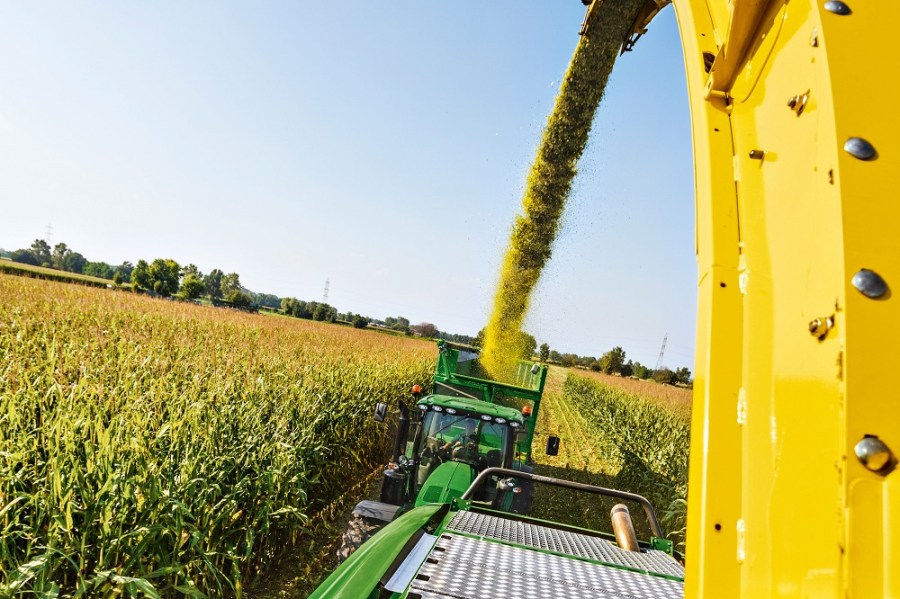Energy maize needs careful early agronomy if it’s to bring maximum fermentation in the AD plant. CPM gets some expert advice.
You’re aiming to produce a different product than maize used for forage.
By Lucy de la Pasture
They’ve been popping up all over the place – large domes dotted across the countryside signify the presence of an anaerobic digester (AD) and purpose-grown energy crops are increasingly being planted to feed them. In 2015, the area of energy maize went up 15% to 33,698ha, according to Defra statistics. That’s 19% of the total maize area grown in the UK.
Some growers would argue that the growth in energy cropping has inflated local land rents, with as much as £600/acre rumoured to be on offer for energy maize ground in the West. Supporters point out AD plants provide a useful resource for turning waste into energy, and can enable alternative cropping strategies that aren’t linked to the volatile commodity markets that affect food crops.
If you’re growing maize for energy, it’s important to get the agronomy right because you’re aiming to produce a different product than maize used for forage, says Simon Draper, agronomist for the Maize Growers Association.
High energy content
“Forage maize requires high energy content in the form of starch, appropriate dry matter to encourage intake (30-35%) and long chop length (12-15mm) for rumen degradability. Maize grown for biogas focuses on maximum yield, a lower dry matter (27-31%) to encourage fermentation and a short chop length (7-10mm) to maximise surface area,” he explains.
“When feeding maize as forage, the aim is to produce as little methane as possible in the rumen. Ruminants can’t digest the lignin and cellulose and the forage passes through the ruminant’s system in 5-10 hours. When producing biogas, exactly the opposite is true, the aim is for maximum methane production and a dwell time of 50-100 days in the digester to allow for the anaerobes to breakdown all of the fibrous tissue.”
The requirement for a ‘big heap’ has led to the development of special energy maize varieties with high yield potential. Their drawback is they’re mostly late maturing and can take up to 260 days to reach their yield potential, comments Shrops independent agronomist, Rupert Bright.
Maize needs around 45 heat units to form a new true leaf and approximately 300 heat units for the plant to fully emerge. Early varieties (FAO 150-160) require around 2100 heat units by the middle of Sept to reach maturity, while later varieties (FAO 180-210) need around 2400 heat units. Later maturing energy maize hybrids, used exclusively for biogas (FAO 240-260) require a longer season with 2800-3000 heat units, depending on drilling date.
“Many growers in Shrops have gone back to planting earlier forage maize varieties to get more timely harvesting and a better entry for following wheat crops. Continuous maize land can afford to have the later maturing biogas types but if planting late can fail to get full cobs” he says.
Tweaking seed rates of existing energy maize varieties may be a better approach than dropping down the variety maturity scale to achieve earlier harvest, according to John Burgess of KWS.
“The trouble with making a wholesale swap out of an energy variety and into a forage variety is the loss in yield potential. For example, Fabregas (FAO 220) can produce yields of around 60t/ha under favourable conditions whereas a forage variety, such as Severus (FAO 170), has a maximum potential of around 45t/ha and will be 5-7% drier.
“The usual approach is to drill 105-110,000 seeds/ha but harvest can be brought forward by 4-5 days by reducing the seed rate slightly to 95-100,000 seeds/ha which allows more light into the crop,” he suggests.
John Burgess says the 2015 season was a reality check for all involved with maize growing, especially after the ‘vintage’ season of 2014 when varieties across the board performed well. With a cool spring, crops got off to a slow start and heat units accumulated at a leisurely pace, resulting in late harvesting problems for some and the added complications they can bring.
“The trend for 2016 is going to be to bring harvest forward, not least because the eye the Environment Agency now has on soil erosion and the cross-compliance issues that late winter maize stubbles could initiate.”
Under the spotlight
Simon Draper agrees that maize is definitely under the spotlight when it comes to cross-compliance issues, especially under GAEC 4, which requires maintenance of a minimum soil cover and GAEC 5, which deals with

Soil management is make or break for the maize crop and contributes 55% when it comes to achieving yield potential, says Simon Draper.
minimising soil erosion.
“At the moment, the guidelines are worded with the caveat of agronomic justification which enables current practice. If this were to disappear, then maize will either need to be undersown with grass or left as maize stubbles. If ploughed or deep cultivated to allow water infiltration, establishing a following crop or cover crop would be another option if left over the winter.
“You could lose some of your scheme payments if you’ve not taken all reasonable steps to prevent erosion over a single area of 1ha or more. What’s more, the penalty will depend on the scale of the soil erosion,” he warns.
But when it comes to growing the maize crop successfully, variety isn’t the main influence in reaching yield potential, notes Simon Draper.
“Soil management is make or break for the maize crop and contributes 55% when it comes to achieving yield potential. Maize is a shy rooter and is extremely sensitive to compaction, which can cause a loss in yield of 30-35%. In a wheat crop, the same level of compaction would only cause a 10% reduction in yield so maintaining soil structure is vital,” he explains.
The top 20-25cm of topsoil hold most of the nutrients and it’s important to keep the soil structure as open as possible to allow the roots to explore the profile. The deep tap roots of maize will penetrate the subsoil to seek out water to a depth equal to the height of the crop if growth is unimpeded.
“As soon as the roots meet a layer of compaction, they give up. One way of getting rid of compaction is to sub-soil,” says Simon Draper. “It’s important to set the sub-soiler up properly and avoid working too deep, below the junction of the top soil and sub-soil. If you work the sub-soil then you can break up the natural fissures and the soil then collapses, which is the opposite to what you’re trying to achieve.”
Going for a fine seedbed is generally the wrong approach, believes Simon Draper. “Using a power harrow to create a fine tilth can create a compacted layer at 10cm depth. The maize will germinate but then begins to struggle. A rougher seed bed is generally better but in May you can go finer as there’s less likelihood of rain after drilling,” he explains.
Major obstacles
One of the major obstacles to overcome with a crop predominantly planted using contractors, is getting drilling done at the correct speed, he points out. “Speed of drilling directly affects the quality of sowing, with best results at 6-8km/h. The faster the drill goes, then plant spacing is reduced and, most importantly, sowing depth becomes more variable, with more gaps in the rows. Yield losses from fast drilling can be up to 40%.
“The most competitive maize plant is its next door neighbour so it’s important to get all seeds germinating at the same time so that there’s a uniform plant stand. Fertiliser needs to be placed a maximum of 2.5cm from the side of

There’s a critical period 4-6 weeks after drilling when the maize needs to be kept weed free, notes Iain Hamilton.
each seed. If any further away, it won’t get picked up,” he advises.
There’s a critical period 4-6 weeks after drilling, 10-30 days post emergence of the crop, when the maize needs to be kept weed free, explains Iain Hamilton of Syngenta.
“The moment a weed appears, the maize plant detects it from changes in light quality and starts to adopt shade avoidance tactics – stem elongation, changes in dry matter allocation and leaf angle. Although we have the chemistry available to take out big weeds, it’s not the right approach in maize.”
Given that a one hit approach won’t necessarily kill all the weeds, why bother with a pre-emergence herbicide? “Because it reduces the weed burden and builds in flexibility for the post-emergence herbicide timing,” says Iain Hamilton.
“A pre-em will help with grassweeds, providing an alternative mode of action where blackgrass is a problem and aids control of difficult broadleaf weeds. At this timing, Dual Gold (s-metolachlor) can be used at 1-1.4 l/ha, with the addition of pendimethalin at 2-3 l/ha to support polygonum control.”
Post-emergence options are mostly based around active ingredient mesotrione (as in Callisto), also available in co-formulation with terbuthylazine (as in Calaris), and nicosulfuron (as in Milagro 240 OD) for broad-spectrum grassweed control and cleavers.
“Milagro plus Calaris offers the broadest spectrum of weed control (£43/ha) with the terbuthylazine component giving more rapid contact activity, 7-10 days after application. Milagro plus Callisto (£36/ha) also offers broad spectrum control, though is weaker on black bindweed, field speedwell and docks. Aim for weed control by the four-leaf stage of the maize for best results,” he concludes.
Getting a boost with N-Lock
Most, if not all nitrogen is applied at the establishment/early stages of the crop and there’s often insufficient nitrogen remaining during the latter stages of crop development, so it’s often a limiting factor when it comes to reaching yield potential, believes Peter Waite of Dow AgroSciences.
“When nitrogen fertiliser is applied to the soil, a nitrification process takes place where the ammonium-nitrogen is converted to nitrite (NO2) by Nitrosomonas bacteria, and then to nitrate (NO3) by the bacteria Nitrobacter,” he explains.
“When nitrogen is in the nitrite and nitrate forms, the nitrogen can be lost through the soil profile by leaching, and in wet conditions can denitrify and be lost to the atmosphere as greenhouse gases. Keeping nitrogen in the ammonium form means it’s attracted to the soil particles so that the nitrogen remains in the rooting zone.”
N-Lock works by inhibiting Nitrosomonas bacteria, preventing them from converting the ammonium to nitrite and any subsequent conversion to nitrate. “It’s this inhibition of the bacteria that helps stabilise the nitrogen, meaning less nitrate can be leached away from the crop’s root zone. So it’s available for longer into the growing season, helping optimise the yield and quality potential,” explains Peter Waite.
Agrovista conducted a variety trial to show the performance of 56 maize varieties and the benefits of N-Lock application at their trial site in Norfolk on a sandy clay loam.
FYM was applied at 8t/ha and ploughed in with the cover crop of rye. Nitrogen was applied to the seed bed at 40kg/ha, followed by 20kg/ha of Nitrogen and Sulphur, applied with a post-emergence herbicide. A Sumo cultivator was run through the soil just prior to drilling to loosen the soil up and create a seedbed.
Pendimethalin was applied pre-emergence at 2.5 l/ha in tank mix with Agrovista’s adjuvant Remix. On the same day N-Lock was applied at the full rate of 2.5 l/ha, followed by 14mm of rain shortly after drilling which was ideal because N-Lock needs to be incorporated into the soil within 10 days of application, either by light cultivation, or with 12mm of rain, explains Agrovista agronomist, Craig Green.
A robust post-emergence herbicide treatment of Elumis (mesotrione+ nicosulfuron) was applied to give a broad spectrum of weed control. This was made at the four true-leaf stage of the crop at the rate of 1.5 l/ha.
“I was pleased with the performance of N-Lock in this maize variety trial. I’d always treated it as a bit of ‘muck and mystery’, but Dow AgroSciences have got it right,” says Craig Green.
“When used on nitrogen-limiting soils, it works well. It certainly seems to prolong what little N there might be in the soil and it seems to have benefits in the maize. Average cob weight in the N-Lock treated varieties was consistently higher than in those that were untreated, and showed a marked increase, particularly in the varieties Ramirez, Kougar, Dualto, Hobbit and Absalon.”




